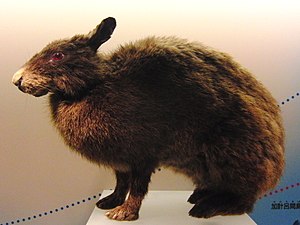Ryukyu rabbit
| Ryukyu rabbit | ||||||||||||
|---|---|---|---|---|---|---|---|---|---|---|---|---|

Ryukyu rabbit ( Pentalagus furnessi ) |
||||||||||||
| Systematics | ||||||||||||
|
||||||||||||
| Scientific name of the genus | ||||||||||||
| Pentalagus | ||||||||||||
| Lyon , 1904 | ||||||||||||
| Scientific name of the species | ||||||||||||
| Pentalagus furnessi | ||||||||||||
| ( Stone , 1900) |
The Ryukyu or Amami rabbit ( Pentalagus furnessi ) is a mammal from the rabbit family (Leporidae) and is one of the most primitive species in its family. Ryukyu rabbits occur exclusively on two islands ( Amami-Ōshima and Tokunoshima ) of the Ryūkyū Islands belonging to Japan , where they are known as Amami no Kuro-usagi ( Japanese 奄 美 野 黒 兎 or 奄 美 の 黒 兎 , German: " Amami's black rabbit ”).
features
The species is characterized by a woolly, dark brown fur, the ears are very short (4 to 5 centimeters). The relatively short limbs have remarkably long claws. Ryukyu rabbits reach a head-trunk length of 40 to 53 centimeters, a tail length of 2 to 3.5 centimeters and a weight of two to three kilograms.
distribution
The two islands of Amami-Ōshima and Tokunoshima have a subtropical climate. The rabbits live here at heights of up to 694 meters ( Yuwandake on Amami-Ōshima, highest point on the islands). The coastal rocks covered with cycads and the hilly oak forests form the natural habitat. After most of the islands were deforested in the 1970s and 1980s, Ryukyu rabbits have also adapted to the Chinese reeds that arose .
behavior
These animals are nocturnal forest dwellers. They leave their burrows on average around 5 p.m. and return around 6 a.m. They dig tunnels 30 to 200 centimeters long, at the ends of which there is a cave of around 20 centimeters in diameter that serves as a place to sleep. Several times a year the female gives birth to two to three young.
An analysis of the food plants revealed at least 29 different types of plants on which Ryukyu rabbits feed. These include sedges , Chinese reeds and hair strands as well as the fruits of pseudo-chestnuts and storax trees . The plants prefer to eat saplings and nuts.
Enemies
Bamboo otters ( Trimeresurus ) were once the only natural predators of rabbits on the islands. Mungos and domestic dogs were later brought into the islands by humans, and they also hunt rabbits today.
Systematics
|
Phylogenetic systematics of the rabbits according to Matthee et al. 2004
|
The Ryukyu rabbit is assigned to the hares (Leporidae) as an independent species and monotypical genus . No subspecies are distinguished within the species. The first scientific description of the species was made in 1829 by the British zoologist Witmer Stone , who described the species as Caprolagus furnessi and thus attributed it to the bristle rabbit . In 1904, Marcus Ward Lyon described the associated monotypic genus.
On the basis of molecular biological data, Conrad A. Matthee et al. In 2004 a cladogram was developed which shows the phylogenetic relationships of the genera within the hares to one another. Accordingly, the Ryukyu rabbit is the sister species of the Bushman hare ( Bunolagus monticularis ), which is only found on river banks in the Karoo desert in western South Africa, and forms a taxon with it . This contrasts with a taxon from the wild rabbit ( Oryctolagus cuniculus ) and the bristle rabbit ( Caprolagus hispidus ), while the cottontail rabbits ( Sylvilagus ) and the dwarf rabbit ( Brachylagus idahoensis ) that live in America represent the sister group of these four species.
Pliopentalagus , which was widespread across Eurasia in the Miocene and Pliocene , is also considered to be closely related to the Ryukyu rabbit .
threat
Before the species was fully protected by the Japanese government in 1921, it was hunted for its meat and suspected medicinal properties. Today, the clearing of forests and the pursuit of stray dogs and cats represent the main threat to the animals. Estimates of the total population amount to around 2000 to 4800 specimens (2003). Most of them live on Amami-Oshima and only 120 to 300 copies on Tokunoshima. The IUCN lists the species as endangered. In order to protect the animals, the Japanese Ministry of the Environment started an action to eradicate the mongooses on the islands in 2005.
The animals usually avoid human proximity. Some animals are kept in captivity on the islands and they can be found in the Kagoshima Zoo .
supporting documents
- ^ A b Conrad A. Matthee, Bettine Jansen Van Vuuren, Diana Bell Terence J. Robinson: A Molecular Supermatrix of the Rabbits and Hares (Leporidae) Allows for the Identification of Five Intercontinental Exchanges During the Miocene. Systematic Biology 53 (3); Pp. 433-447. ( Abstract )
- ↑ a b Don E. Wilson & DeeAnn M. Reeder (eds.): Pentalagus furnessi ( Memento of the original from December 15, 2016 in the Internet Archive ) Info: The archive link was inserted automatically and has not yet been checked. Please check the original and archive link according to the instructions and then remove this notice. in Mammal Species of the World. A Taxonomic and Geographic Reference (3rd ed).
- ^ Witmer Stone: Descriptions of a New Rabbit from the Liu Kiu Islands and a New Flying Squirrel from Borneo . In: Proceedings of the Academy of Natural Sciences of Philadelphia . tape 52 , 1900, pp. 460–463 ( online [accessed June 19, 2015]).
literature
- Ronald M. Nowak: Walker's Mammals of the World. Johns Hopkins University Press, Baltimore 1999, ISBN 0-8018-5789-9
- Fumio Yamada, Fernando A. Cervantes: Pentalagus furnessi. In: Mammalian Species . No. 782, 2005.
Web links
- Pentalagus furnessi in the endangered Red List species the IUCN 2008. Posted by: F. Yamada, K. Sugimura, 2008. Accessed January 2 of 2009.
